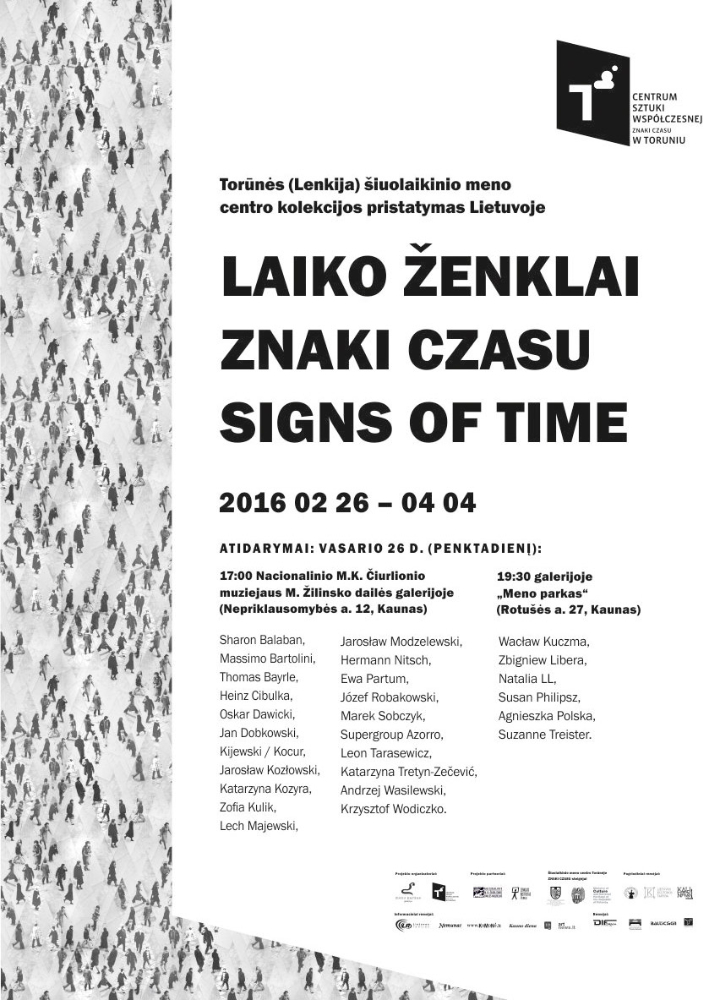
On February 26th (Friday) gallery “Meno parkas” and Toruń’s (Poland) Centre of Contemporary Art invites to the openings of the project’s “Signs of Time” exhibitions at Mykolas Žilinskas Art Gallery and gallery “Meno parkas”. Project curator Krzysztof Stanisławski (PL).
5 p.m. – at Mykolas Žilinskas Art Gallery of M.K. Čiurlionis National Museum of Art (Nepriklausomybės a. 12, Kaunas).
Artists: Thomas Bayrle, Sharon Balaban, Massimo Bartolini, Heinz Cibulka, Oskar Dawicki, Jan Dobkowski, Kijewski / Kocur, Jarosław Kozłowski, Katarzyna Kozyra, Zofia Kulik, Lech Majewski, Jarosław Modzelewski, Hermann Nitsch, Ewa Partum, Józef Robakowski, Marek Sobczyk, Supergroup Azorro, Leon Tarasewicz, Katarzyna Tretyn-Zečević, Andrzej Wasilewski, Krzysztof Wodiczko.
7.30 p.m. – at the gallery “Meno parkas“ (Rotušės a. 27, Kaunas)
Artists: Wacław Kuczma, Zbigniew Libera, Natalia LL, Susan Philipsz, Agnieszka Polska, Suzanne Treister.
Guests of honour:
President of Toruń City Mr. Michał Zalewski and Mayor of Kaunas City Visvaldas Matijošaitis.
Partners of the project: Polish Institute in Vilnius, M. K. Čiurlionis National Art Museum.
Works of Polish and international artists comprising the collection of the Toruń–based “Signs of Time” Centre of Contemporary Art (CoCA) on display at the Mykolas Žilinskas Art Gallery of the M. K. Čiurlionis National Art Museum as well as “Meno parkas” Gallery in Kaunas.
Its the first show of the collection abroad, and the first such comprehensive exhibition of Polish art in Lithuania in the past 12 years. Opened in 1989 to commemorate and house the works of the renowned collector Mykolas Żilinskas (1904–22), the Kaunas–based gallery appears is an excellent place to showcase works from another collection and “Meno parkas” contemporary art Gallery, in turn, is one of the most vibrant art institutions in the country, collaborating with many European art communities.
The exhibition includes paintings, drawings, photographs, videos and installations by artists regarded as classic creators of Polish art, accompanied by several stars of the international art world as well as young art starlets.
The selection of works provides a genuine testimony to the times from which they originate, being representative of various periods and trends in contemporary (mainly Polish) art. The works have not been thematically grouped according to problems that would be more or less consistent with Krzysztof Stanisławski’s curatorial concept. Quite the contrary – the curator’s intention was rather to hide behind the most original works, characterised by unparalleled artistic level and reflecting the “spirit of their time”, without a plan clearly focused on any particular theme or problem.
The earliest artworks date back to 60s and 70s. and the martial law period, although they are definitely not typical of the “New Expression” style dominant at the time. They include the iconic video by Józef Robakowski and a documentation of the equally iconic performance by Ewa Patrum. Once considered radically alternative, those creators eventually gained wide recognition at home and abroad (note Patrum’s and Robakowski’s works in New York’s MoMA on the exhibition „Transmissions” opened till 3rd Jan., 2016). The above–mentioned New Expression of the 1980s is reminded by much later works of the renowned painters: Leon Tarasewicz and members of Gruppa: Jarosław Modzelewski and Marek Sobczyk.
The 1970s are represented by later but similarly–styled works of such artists as Natalia LL (also present at MoMA), Jarosław Kozłowski or Jan Dobkowski. The 1990s, with the dominant “critical art” of that period, are represented by Katarzyna Kozyra and SuperGrupa Azorro (Igor Krenz, Woj–ciech Niedzielko, Łukasz Skąpski and Oskar Dawicki, also featured as an independent artist). This trend also encompassed (although indirectly) such pioneering artists as Zofia Kulik and Zbigniew Libera. Noteworthy creators of the youngest generation include Agnieszka Polska, Basia Bańda and Katarzyna Tretyn-Zečević.
The collection of artworks by Polish artists is complemented by a number of foreign authors, which emphasises the international context, constituting an attempt at searching for points of reference (even if indirect and non–obvious) to trends and problems discussed by West European artists. The most interesting items in this section include documentations and works by Viennese Actionists – Heinz Cibulka and Hermann Nitsch – along with a work by the star of the recent documenta, Thomas Bayrle, or a sound installation by the Turner Prize winner Susan Philipsz.
Equally important is the presentation of established artists usually working outside Poland, e.g. Krzysztof Wodiczko from New York (installation in the Polish Pavilion at the Venice Biennale) or Lech Majewski, sharing his time between Katowice, Venice and the rest of the world, whose video art and films have recently been on display at MoMA, and previously at several editions of the Venice Biennale.
Exhibitions will be opened till 4th of April.
























